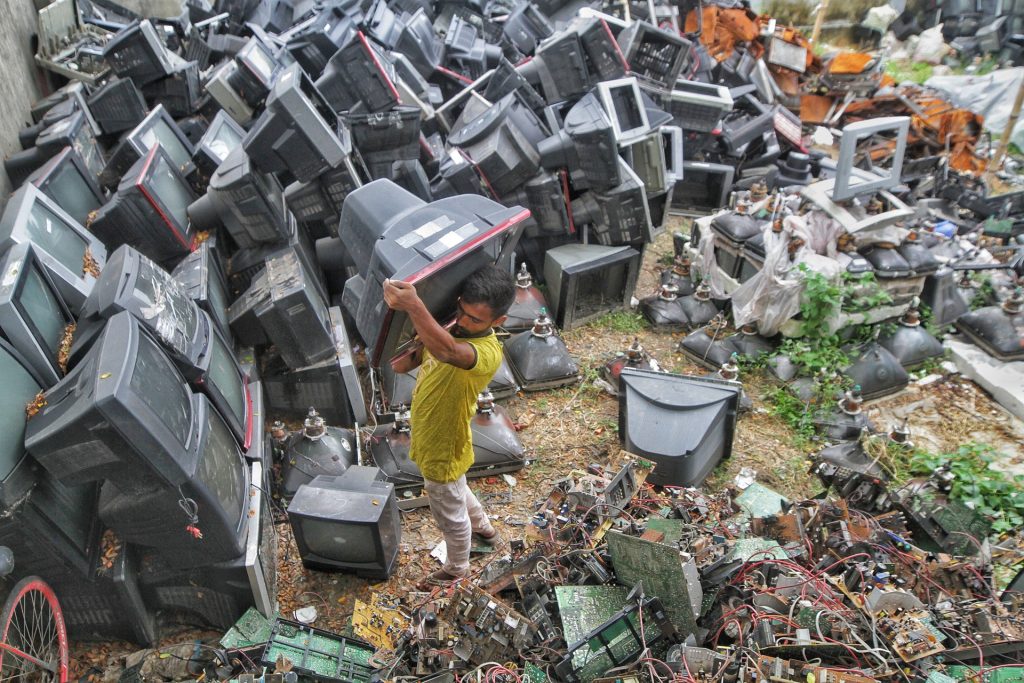E-Waste
Ameerat Saidi; Anny Jaimes; Gabriel Fajardo; Joshua Whyte; and Roshani Dangol

Introduction
The term “e-waste” refers to the waste produced during the manufacturing and disposal of electronics, also known as Electronic Waste. E-waste is an abbreviation for electronics and electrical equipment and its elements that have been discarded by the owners. E-waste includes everything from a little product like a wiring wire to a large product like a refrigerator that has been used. Products that fall under the categories of e-waste are screens, monitors, home appliances; telecommunication equipment like printers, mobile phones, power strips, etc.
Topic Overview
Electronics are made from many harmful chemicals, including mercury, lead, and indium oxide. The amount of waste produced can be surprising given that all of these are extremely harmful to the environment and that the majority of smartphone users replace their phone every 18 months on average (Chen, 2011). Electronic waste is one of the most harmful and least recyclable waste streams on the planet. In fact, fifty million tons of e-waste are produced each year, with forty million tons ending up in landfills and dumpsites (UN Report: Time to Seize Opportunity, Tackle Challenge of E-waste, n.d.). However, many of us are still unaware of what e-waste is. This paper aims to enumerate perspectives on e-waste from local and global lenses. The paper will provide a critical analysis on the main issues of each locale. The analyses would then be supported by local and global solutions from pioneers in the industry. The conclusion gives a brief summary on the issues surrounding e-waste and the respective solutions of local and global leaders in sustainability.
For information on how to access the transcript for this video, see
Local and Global Perspectives
For the local perspectives, we decided to talk about the three largest e-waste producing countries. On the first hand we have the USA, China, India, and Canada that generate the most e-waste. Only 17.4% of e-waste is known to be collected and recycled appropriately (Wikipedia contributors, 2022). Estonia, Norway, and Iceland have the greatest rates of e-waste recycling.
The United States produces the most e-waste, followed closely by China and India; these countries recycle and export e-waste globally.
According to the Environmental Protection Agency (EPA), the United States disposed of 2.37 million tons of e-waste in 2009, 25% of which was recycled domestically (U.S. Environmental Protection Agency, n.d.).
E-waste management in the United States includes recycling and reuse initiatives, domestic landfill dumping, and worldwide shipments of domestically created e-waste.
Between 50% and 70% of e-waste collected in the United States for recycling is transported to developing countries, where it is commonly recycled in Asia and West Africa’s informal recycling sectors. China has the highest volume of e-recycling, followed by India, Nigeria, and Ghana.
China is looking to make a total of $23.8 billion USD by 2030 from urban mining (Greenpeace East Asia, 2019). Ten million MT was collected in China in 2019 (Tiseo, 2022). Some in Guiyu have reported to have health problems after being exposed to chemicals used to strip the valuable metals from e-waste (Whitacre, n.d.). E-waste and e-waste recycling are proving to be environmentally and physically harmful.
Electronic Waste constitutes only 0.4% of the large waste in Toronto (City of Toronto, 2020). Services like Greentronics Computer Recycling at 1920 Yonge St offer: E-Waste pick-up, Secure Data Destruction, Computer/Smartphone Service and Repair (Greentronics recycling, n.d.).
On the other hand, India is considered the third largest producer of electronic waste in the world. India produces over 3.23 million metric tons of e-waste every year. The pandemic has accelerated the demand for electronic devices. More than 38 million units were sold during the pandemic and now more than 500 million Indians use smartphones. By the end of 2020, close to 8 million laptops were shipped to India and that translates to more e-waste (Rao, 2021).
Critical Analysis
The World Health Organization wrote the article “Soaring E-waste Affects the Health of Millions of Children, WHO Warns” (2021) which mentions the major idea is the growing number of women and children who are exposed to harmful components from e-waste, and what leaders in the public sector, business operators, and the health sector should do in response. Because of the quantity and complexity of this waste, electronic waste, or e-waste, is a growing global concern. The article attempts to educate and mobilize people by holding the technology industry and the government responsible for proper e-waste disposal and pushing the healthcare sector to monitor and protect children from e-waste exposure. The article also encourages the public and private sectors to follow the recommendations of a WHO report titled “Children and digital dumpsites: e-waste exposure and child health.”

Local and Global Solutions
As manufacturers struggle against the Right to Repair (Singal, 2022) and tech-savvy consumers continue to update, e-waste is becoming a rising global issue.
It is anticipated that by 2030, there will be 75 million tons of e-waste on the earth, about double the amount in 2014. However, inventive manufacturers and developers are devising e-waste solutions. Some individual solutions to handle the e-waste crisis is to realize some aspects such as: 1. Is there a need for a new electronic device? 2. How old is the current device? 3. Is the device still working? 4. Is the device still usable? (Business Insider India, 2022).
Many countries around the globe have created institutions to reuse and repurpose electronic devices. These institutions work on three levels: Reuse, Repair, and Recycle. Reuse: Try to extend the lifetime of your devices. Repair: When you repair electronics you are stopping them from becoming e waste. Recycle: Recycling helps to minimize the environmental effects of e-waste.
According to WasteAid, an international group of experts promoting waste sustainability, waste burning accounts for up to 10% of global climate change emissions, and one in every three individuals worldwide is driven to dump or burn their waste, creating pollution and disease (WasteAid, n.d.). By implementing responsible waste management, the organization is working to enhance livelihoods and build a healthier future for everyone.
At Global E-Waste Solutions, they believe in doing their share to lessen the environmental effect and foster community goodwill. When you recycle your electronics, you are helping your community and the planet at large. The organization teaches e-waste literacy, and introduces local resources to recycle and dispose of e-waste responsibly (Global Ewaste Solutions, 2018).
Conclusion
Overall e-waste is a growing problem that needs solutions, and many have come about, whether they be at a government level or through community engagement or even non-profit organizations. E-waste is a problem that practically all countries face universally, but especially developing countries because e-waste is produced in large quantities. As a result, each of us must commit to reducing waste and using, reusing, and recycling all e-waste.
References
Adams, H. S. (2022, March 22). Top 10 solutions for electronic waste. Manufacturing Digital. Retrieved December 13, 2022, from https://manufacturingdigital.com/procurement-and-supply-chain/top-10-solutions-for-electronic-waste
Admin, E. R. I. (2022, June 13). Top electronic waste trends of 2022. ERI. Retrieved December 13, 2022, from https://eridirect.com/blog/2022/06/top-electronic-waste-trends-of-2022/
BB Agency. (2022, July 13). Toronto. Electronic Recycling Association Computer Recycling and Donations. Retrieved December 13, 2022, from https://www.era.ca/locations-ca/electronic-recycling-toronto/?_gl=1%2Agfxnq9%2A_gcl_aw%2AR0NMLjE2NzAzNTgxNzcuQ2owS0NRaUE3YnVjQmhDZUFSSXNBSU93ci0tMV9uYURtdDFGaTM0N1Y3c3d4bk5oelNQcUNWWTB5ak5WQ2s0LVVISUJ0UmthTmZvXzJJZ2FBdjNWRUFMd193Y0I.&_ga=2.236866695.728648868.1670358177-484411775.1670358177&_gac=1.258381304.1670358833.Cj0KCQiA7bucBhCeARIsAIOwr–1_naDmt1Fi347V7swxnNhzSPqCVY0yjNVCk4-UHIBtRkaNfo_2IgaAv3VEALw_wcB[LS1]
BB Agency. (2022, November 21). Home page. Computer Recycling Vancouver Calgary Edmonton Saskatoon Winnipeg Toronto Montreal. Electronic Recycling Association Computer Recycling and Donations. Retrieved December 13, 2022, from https://www.era.ca/
Business Insider India. (2022). How E-Waste Affects Our Health And Environment [Video]. YouTube. Retrieved December 13, 2022, from https://www.youtube.com/watch?v=C84sEoaDMRc
Chen, J. (2011, February 25). People upgrade mobile phones every 18 months on average. Gizmodo Australia. Retrieved December 16, 2022, from https://www.gizmodo.com.au/2011/02/people-upgrade-mobile-phones-every-18-months-on-average/
AET Group Inc. (n.d.). 2020 Litter Audit – Toronto. City of Toronto. Retrieved November 22, 2022, from https://www.toronto.ca/wp-content/uploads/2021/02/8de3-Toronto-Litter-2020Final-Report.pdf
Conclusion-What You Can Do – Electronic Waste, n.d. https://sites.google.com/site/journeyofewaste/home/-conclusion[LSC4]
Global Ewaste Solutions. (2018). https://www.globalewaste.net
GreenTronics Computer Recycling. (n.d.). Retrieved November 22, 2022, from https://greentronicsrecycling.ca
Microsoft. (n.d.). Bing. Retrieved December 13, 2022, from https://www.bing.com/videos/search?q=e%2Bwaste%2Bpollution%2Bthreat%2Bto%2Bhuman%2Bhealth&&view=detail&mid=9F1D2A93FAA769F44D339F1D2A93FAA769F44D33&FORM=VRDGAR&ru=%2Fvideos%2Fsearch%3Fq%3De%2520waste%2520pollution%2520threat%2520to%2520human%2520health%26qs%3DUT%26form%3DQBVR%26%3D%2525eManage%2520Your%2520Search%2520History%2525E%26sp%3D2%26ghc%3D1%26pq%3De%2520waste%2520pollu%26sk%3DOS1%26sc%3D10-13%26cvid%3D2707D34242C6420699E0DEA0D68B0B4D[LS5]
Recykal. (2021, June 21). An introduction to e-waste. Retrieved December 13, 2022, from https://recykal.com/2021/06/21/an-introduction-to-e-waste/
Singal, N. (2022, July 15). What is ‘right to repair’, touted to empower consumers? Business Today. Retrieved December 16, 2022, from https://www.businesstoday.in/latest/economy/story/what-is-right-to-repair-touted-to-empower-consumers-341626-2022-07-15
U.S. Environmental Protection Agency. (n.d.). Retrieved December 16, 2022, from https://www.epa.gov/
WasteAid. (n.d.). Homepage – WasteAid. Retrieved December 16, 2022, from https://wasteaid.org/
Whitacre, P. T. (n.d.). E-waste recycling in China: A health disaster in the making? National Institute of Environmental Health Sciences. Retrieved November 22, 2022, from https://www.niehs.nih.gov/research/programs/geh/geh_newsletter/2013/7/articles/ewaste_recycling_in_china_a_health_disaster_in_the_making.cfm
Electronic waste in the United States. (2022, November 24). In Wikipedia. Retrieved December 13, 2022, from https://en.wikipedia.org/wiki/Electronic_waste_in_the_United_States#:~:text=Electronic%20waste%20or%20e-waste%20in%20the%20United%20States,waste%20and%20can%20have%20serious%20health%20impacts.%20
van Dijk, B. (n.d.). Guiyu e-waste. Openverse. Retrieved December 13, 2022, from https://wordpress.org/openverse/image/7c8e2b12-f890-456e-87cb-e41150dcf67e

